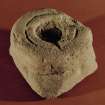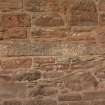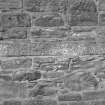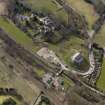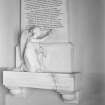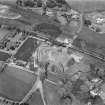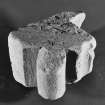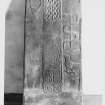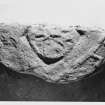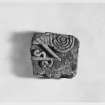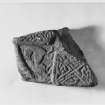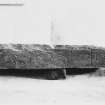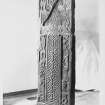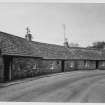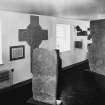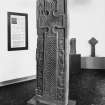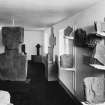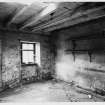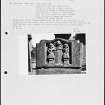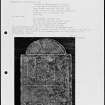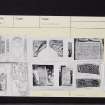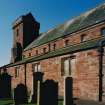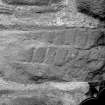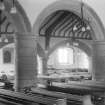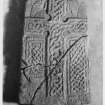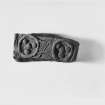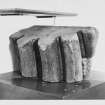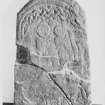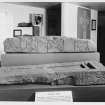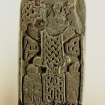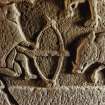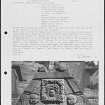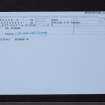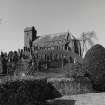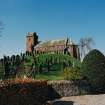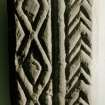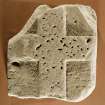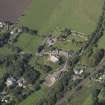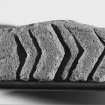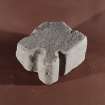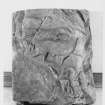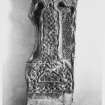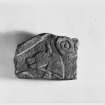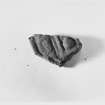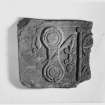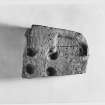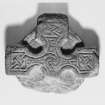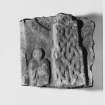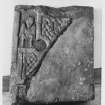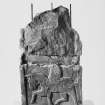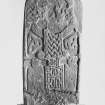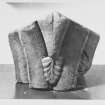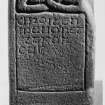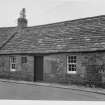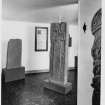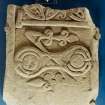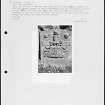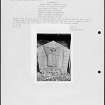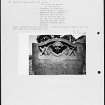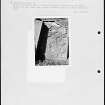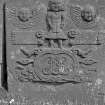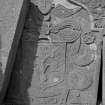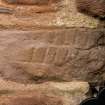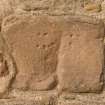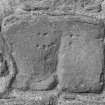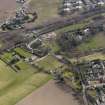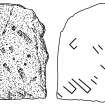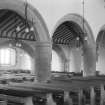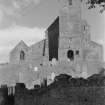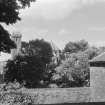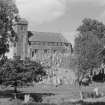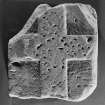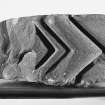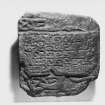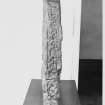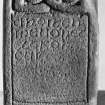St Vigeans, Kirkstyle, St Vigeans Parish Church And Churchyard
Burial Ground (Period Unassigned), Church (12th Century), Human Remains(S) (Period Unassigned), War Memorial (20th Century) (1920)
Site Name St Vigeans, Kirkstyle, St Vigeans Parish Church And Churchyard
Classification Burial Ground (Period Unassigned), Church (12th Century), Human Remains(S) (Period Unassigned), War Memorial (20th Century) (1920)
Canmore ID 35559
Site Number NO64SW 3
NGR NO 63842 42912
Datum OSGB36 - NGR
Permalink http://canmore.org.uk/site/35559
First 100 images shown. See the Collections panel (below) for a link to all digital images.
- Council Angus
- Parish Arbroath And St Vigeans
- Former Region Tayside
- Former District Angus
- Former County Angus
St Vigeans Church & Churchyard (St Féchín)
This early church site, perched on a knoll, has yielded over the nineteenth and twentieth centuries some 40 early medieval carved fragments, found built into the walls of the church or buried in the graveyard. The collection spans the eighth and ninth centuries and is dominated by cross-slabs, but there are also fragments of three or four free-standing crosses, four recumbent graveslabs, and two cross-marked boulders. Among the more unusual monuments are a solid house-shrine (no 29), a pillar cross (no 16) and a furnishing finial (no 27). Six of the stones incorporate Pictish symbols into their ornament (nos 1-6), and there is a wide variety of interlaced, key and spiral patterns. Among the figural scenes, a crouched archer, holy men in long tunics with embroidered hems and depictions of chairs stand out, as does the iconography of St Antony and St Paul. Among the animals on the stones, a fine seated stag, a supercilious bird with elaborate plumage, a tusked boar and a bear are memorable. Sculptural technique ranges from incision to high relief.
St Vigianus is now identified as the Irish St Fechin.
Primary reference: Geddes 2017
A Ritchie 2019
Field Visit (9 June 1958)
The 15th century fabric of St Vigeans Church remains as described (W tower, nave, and S aisle are all of this period) and is in an excellent state of preservation. The church is in use for public worship.
Visited by OS (JLD) 9 June 1958
Desk Based Assessment (1958)
NO64SW 3.00 63842 42912
NO64SW 3.37 63842 42936 Churchyard Walls
NO64SW 3.01 to NO64SW 3.30 NO 6383 4294 Pictish Cross-Slab; Pictish Symbol Stone; Cross-Slab; Sculptured Stones.
NO64SW 3.38 Cross-slab (possible)
(NO 6384 4291) Ch (NAT) Sculptured Stones found 1871 and 1888 (NAT)
OS 1:10000 map (1975)
St Vigean's Church occupies nearly the whole of the summit of a regularly shaped mound which has been the site of a religious settlement from a very remote period. This is shown by several Norman wrought stones that have been found on the site as well as a large and most important group of elaborately carved sculptured stones, relics of the Celtic church which once stood here. Vigianus has been recognised as the Latinised form of the name of St Fechin of Fohbar, an Irish saint who died in 664.
Previous to a restoration in 1871, the church consisted of a central nave of eight bays, with north and south aisles and a western tower. The original Norman church appears to have occupied the site of the north aisle and to have extended in width to about the centre of the present nave. Parts of the east and west gable walls still remain. At a later period, probably about the middle of the 15th century, the church was extended to the south and was converted into a building with a nave and a north aisle; and again at a still later period, in 1485, the south wall was taken down and a south aisle erected.
In 1871 considerable additions were made including a large apse, a second north aisle and the raising of the tower. The church was consecrated in 1242 by Bishop de Bernham and reconsecrated after the 1485 additions.
D MacGibbon and T Ross 1897
Information from OS Index Card, c. 1958.
Source: D MacGibbon and T Ross 1897
Photographic Survey (1959)
Photographic survey by the Scottish National Buildings Record in 1959.
Photographic Survey (March 1961)
Photographs of buildings in St Vigeans, Angus, by the Scottish National Buildings Record in March 1961.
External Reference (1 October 1965)
The symbol stones are housed in a small museum at NO 6383 4294.
Information from DoE telecommunication 1 October 1965.
Publication Account (1982)
The church of St.Vigeans located about a mile from the Abbey served as Arbroath's parish church in the middle ages. St. Vigeans stands on a small conical mound and has some twelfth century fragments in its fabric, though the site itself was a Celtic one (MacKie, 1954, 5). The early Christian site is attested by the large and most important group of elaborately carved stones... which once stood here' (MacGibbon and Ross, 1897, 459). For a few years after the Reformation the Lady Chapel was used as the parish church until 1590, when it was abandoned for a square, box-like edifice made out of stone and timber from the Abbey Dormitory (MacKie, 1954, 16). This church was repaired in 1751 (Hay, 1876, 91), and was enlarged in 1764 (NSA, 1843, 94). A modern church is now built on the site.
Information from ‘Historic Arbroath: The Archaeological Implications of Development’, (1982).
Reference (1997)
Six class II symbol stones.
St Vigeans 1 (The Drosten Stone) : on cross face decoration including an angel with animals and birds and inscription in Hiberno-Saxon script.On the reverse a complex hunting scene with underneath a double-disc and Z-rod over a crescent and mirror-and-comb.
St Vigeans 2 : cross shaft with a mirror on the left and serpent and Z-rod over an eagle on the right.
St Vigeans 3 : fragment with double-disc and Z-rod.
St Vigeans 4 : on the reverse is a standing figure with vertical double-disc on the right.
St Vigeans 5 : fragment with double-disc and Z-rod on the cross face.
St Vigeans 6 : double-disc and Z-rod on one face.
A Mack 1997
Watching Brief (20 November 2007)
NO 639 429 A watching brief was maintained on 20 November 2007 during the excavation of 18 postholes for a new boundary fence and the removal of an earth bank at the rear of the property. 0.6m of rich dark brown
garden soil was recorded in each posthole and the earth bank was composed of a similar soil, indicating that the site may have been levelled and landscaped using soil from the market garden that once existed in the area, following the destruction of a nearby cottage by fire in the late 20th century. The earth bank contained building debris from the demolished cottage including large, dressed sandstone blocks. Nothing of archaeological significance was found in the postholes.
A watching brief was undertaken February 2008 during excavations for a septic tank, a soak-away and a trench to connect the septic tank to the back of the museum. Up to 2m of dark brown silt and below this natural grey boulder clay were recorded to a depth of up to 3m. Nothing of archaeological interest was found.
A watching brief was also maintained during the exposure of a stone believed to be a Pictish symbol stone built into the external S wall of St Vigeans Church. A small amount of 15th-century wall fabric and lime mortar was removed from above and below the stone, revealing a carved surface over the underside and back edge of the stone. A deep groove in the extreme W edge of the stone indicated that the stone was a recumbent slab. This was also suggested by the uncarved rough upper face of the stone which would once have been face down in the ground, possibly against a wall with the carved back edge of the stone on display and possibly a wooden or stone upright in the deep groove. The stone was exposed to reveal the extent and character of the
carving but it was not removed from the wall.
Sarah Hogg 2008
Sponsor: Historic Scotland
Kirkdale Archaeology
Watching Brief (18 February 2008 - 21 February 2008)
A watching brief was undertaken February 2008 during excavations for a septic tank, a soak-away and a trench to connect the septic tank to the back of the museum. Up to 2m of dark brown silt and below this natural grey boulder clay were recorded to a depth of up to 3m. Nothing of archaeological interest was found.
A watching brief was also maintained during the exposure of a stone believed to be a Pictish symbol stone built into the external S wall of St Vigeans Church. A small amount of 15th-century wall fabric and lime mortar was removed from above and below the stone, revealing a carved surface over the underside and back edge of the stone. A deep groove in the extreme W edge of the stone indicated that the stone was a recumbent slab. This was also suggested by the uncarved rough upper face of the stone which would once have been face down in the ground, possibly against a wall with the carved back edge of the stone on display and possibly a wooden or stone upright in the deep groove. The stone was exposed to reveal the extent and character of the carving but it was not removed from the wall.
Sarah Hogg 2008
Sponsor: Historic Scotland
Kirkdale Archaeology
Watching Brief (2008)
NO 6384 4291 This church dates from the 12th century although there may have been a Christian foundation there since the 7th century. There were additions and modifications to the church in the 13th, 15th and 19th centuries and recently it underwent a programme of consolidation. Since then some of the drains taking rainwater from the church roof have become blocked, necessitating the excavation of trenches to locate and
replace those drains. A watching brief was maintained during the excavation of these small trenches, three against the N wall of the church and four against its S wall. No features of archaeological significance were uncovered, although several disarticulated human bones were recovered where the existing drains had cut through earlier deposits.
Archive and Report: Aberdeenshire Council SMR and RCAHMS
Funder: The Congregational Board of St Vigeans Parish Church
J Lewis (Scotia Archaeology), 2008
Watching Brief (14 March 2022 - 30 March 2022)
NO 63849 42882 A watching brief was maintained during excavation for new drainage and paths from 14–30 March 2022. Some of the area had already been disturbed and very little of archaeological interest was excavated; some disarticulated human bone were recovered as well as 19th- to early 20th-century finds. Archive: NRHE
Funder: Congregational Board of St Vigeans Church
Moyra Simon – Cameron Archaeology
(Source DES Volume 23)










































































































